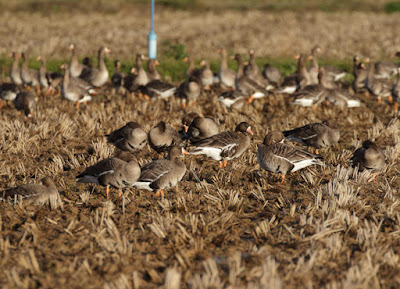I'd really been hoping to find the local wintering Taiga Bean Geese near Izumo which, though apparently within middendorffii, have slightly different mtDNA and hale from outside the recognised middendorffii breeding range and I gather are morphologically slightly different to the Lake Biwa population.
I find the Lake Biwa birds extremely variable which may simply be down to the inherent individual variation that can be expected within any goose gathering. Not only might I be barking up the wrong tree but there may not even be a tree to bark up. However I'm curious whether Shimane-type Beans also occur at Lake Biwa as it could account for differences I see at Biwako where even setting aside the small number of serrirostris that occur there often seem to be two groups; the obvious swan-like middendorffii and deeper-, shorter-billed birds.
Below is an old digiscoped image which gives an idea of what I mean. I was looking at this flock of middendorffii when the three birds in the foreground dropped in nearby and swam past the flock without joining it. The middendorffii have long bills with a slightly concave culmen and a pronounced bulbous tip. The three geese in the foreground have deeper-based bills with a deeper grin patch and a straight culmen from forehead to tip which almost creates a droop-tipped appearance, quite different to the stand-out middendorffii behind them. As I say there may be nothing more than individual variation in this but it's interesting how often these two types seem to form discrete groups within the flock.
 Three geese which seem to have deeper-based triangular bills (and consequently more prominent grin patches) lacking the bulbous tip extension shown by all the geese in the background.
Three geese which seem to have deeper-based triangular bills (and consequently more prominent grin patches) lacking the bulbous tip extension shown by all the geese in the background.Getting a good look at the Shimane birds would at least give an idea whether or not the idea might be worth looking into but unfortunately I wasn't able to locate any on the ground and only saw a very distant flock of about 70-80 in flight, identifiable by call. Greater White-fronted Goose was an altogether easier proposition. I saw the first ones roosting on a river at daybreak and small parties were frequent overhead as the sun came up. After locating a few on the ground more began to arrive.
Heads in the grass...
Most of the immatures have a dark nail and some other dark markings along the cutting edge to go with the limited white blaze, others have lost all trace of dark on the nail.
From another angle they weren't quite as in-the-grass as they'd seemed at first.
There were plenty of Tundra Swans around too, this stretch of coast can host large numbers on any suitable fields close to water.
























No comments:
Post a Comment